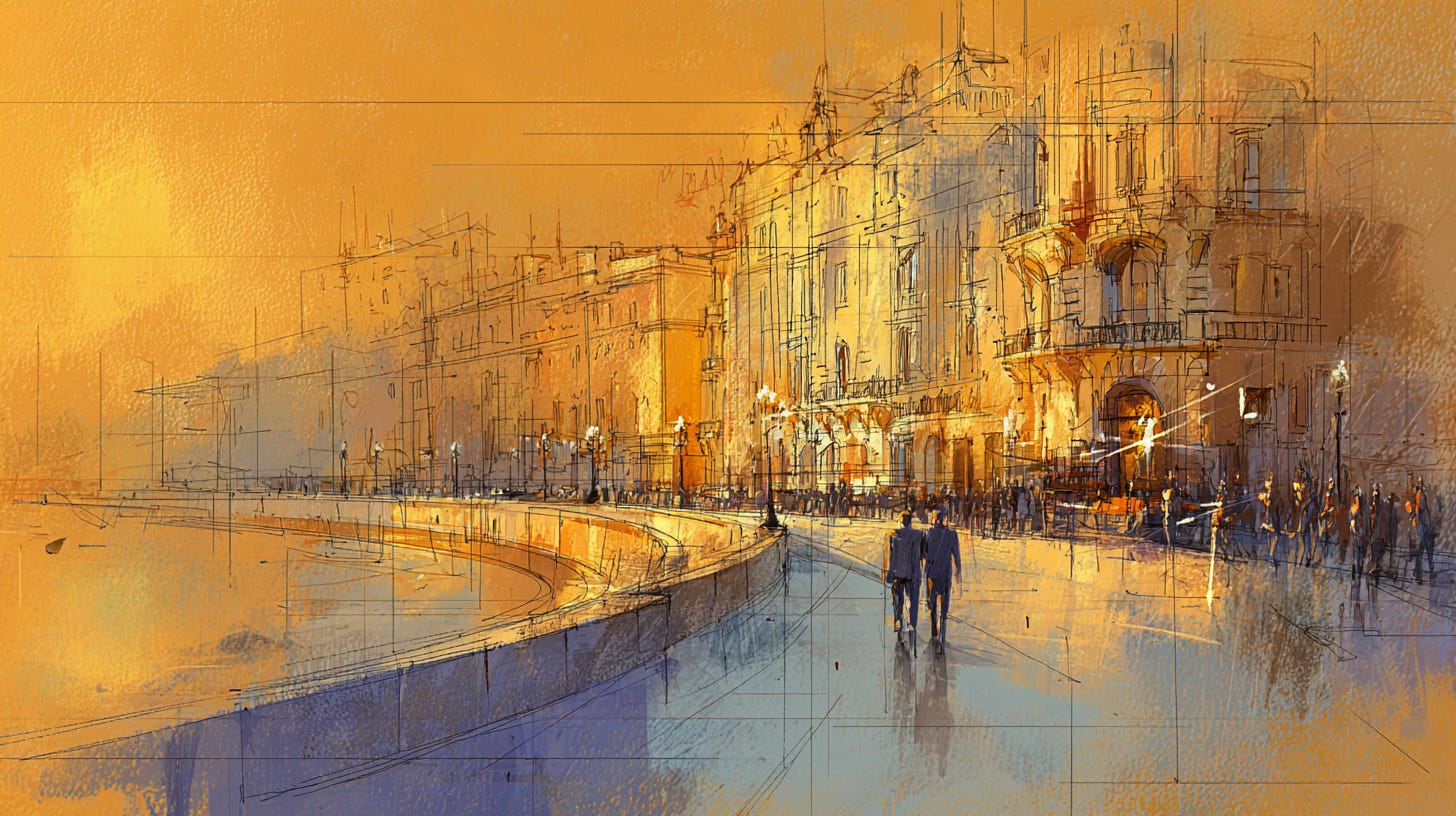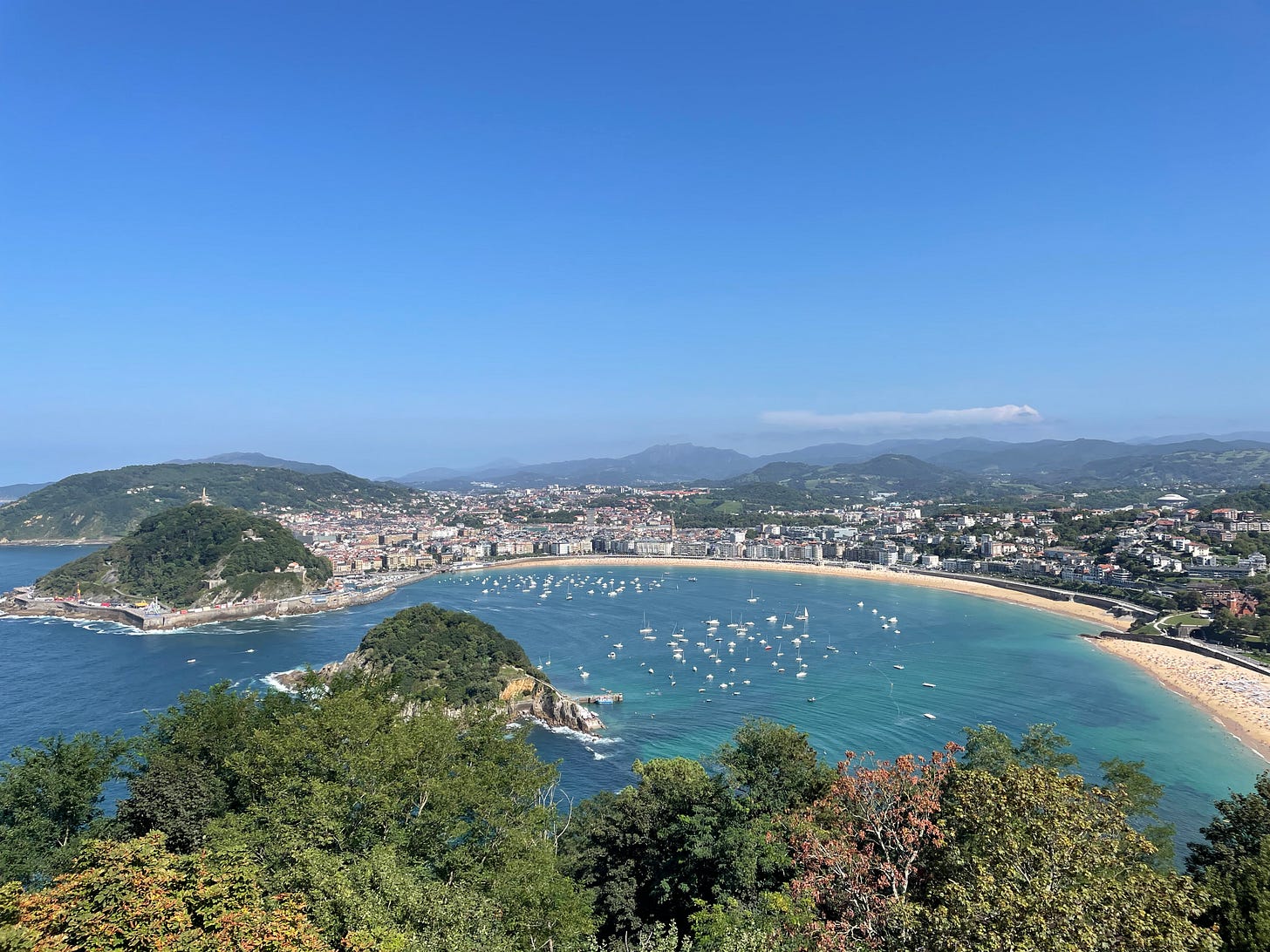The Urban Romantic
Falling in Love with the City
Note to readers: I’m exploring ideas for deeper-dive essays and would love your input. There’s a short survey at the end—thanks for weighing in! —RP
Have you ever been in love?
Love wasn’t on my mind when I was a child, but the object of my curiosity appeared nightly on the evening news—and, one early dawn, as we drove south on the Jersey Turnpike, I saw it with my own eyes: Manhattan’s spires silhouetted against the sky. Growing up in suburban Connecticut, I flirted with cities at the edges: an errand in New Haven, a game in Hartford, a field trip to Boston—nothing serious. These places left sensory traces more than memories: the blur of a yellow cab, the wail of a siren, hot subway air rising through sidewalk grates, neon light pooling in the night. The city as I knew it was sound, pulse, heat, color—the disembodied ephemera of a fleeting embrace, not something to be studied, savored, sustained.
And then I had my first teen romance.
In the summer of 1998, my family hosted a student from San Sebastián in Spain. In advance of his visit, he’d sent photos of his family and a book about his hometown. Far from a place of dusty castles and bloodstained matadors, here were his stylish parents descending the stairs at the film festival, a red carpet sweeping across a city sculpted from caramel, its streetlights and stars reflected in a glittering bay. Already, I was smitten.
The next summer, weeks shy of sixteen, I went to visit him in San Sebastián. I flew to Europe alone and was met at the Bilbao gate by my friend and his family amid a flurry of cheek-kisses and rapid-fire Spanish greetings. For the duration of the next two weeks, my friend would be my interpreter and my guide—indeed, I would see the city largely through his eyes.
The drive along the autopista was uneventful; the descent onto a boulevard of plain apartment blocks, uninspiring. But then the city unfolded before me: tree-lined streets, bustling shopfronts, façades filigreed and cast in caramel-colored stone. As the blocks gave way, something in me opened, too—a sense of possibility quickening. By the time we reached their apartment building in Gros, tucked into this dense, humming fabric, I already knew the aperture of my world had widened. Their apartment was unlike any I’d seen back home, with its high ceilings, kitchen clad in Venetian plaster, and corner salon with a view toward the Bay of Biscay. Back in Connecticut, my friend and his Spanish classmates had thought our modest single-family homes were palatial estates. But here, in a city of actual palaces, this apartment was a jewel box.
After getting settled, my friend was eager to show me his city, so we strapped on helmets and hopped on his moped. The engine purred to life—gasoline thick in the air, sweet as an aphrodisiac—and then we were off. The city streaked by in a blur: the sharp angles of the Kursaal, the stately hotels and theaters I’d ogled in the photobook, the twelve-meter Jesus towering over Monte Urgull. And then suddenly, the Bay of La Concha: glassy and still, framed by promenades and palaces, the tunnel ahead drawing us toward Ondarreta, his friends’ favorite beach. We parked, and my legs wobbled—perhaps from the ride, perhaps from the view. Monte Igueldo, Isla de Santa Clara, and Monte Urgull punctuated the bay like an ellipsis. My friend looked on with the easy indifference of someone who’d grown up inside a postcard—but I was falling hard for this place.
Back on the moped as the sun sank into the sea, we raced home beneath a molten sky as the buildings came aglow. I had seen this before in the photobook. Still, I was shocked to find myself inside a real-life impressionistic painting, with wind in my hair and salt on my lips. At the apartment, my friend’s mother set out bread and thin slices of chorizo. The smoky fat melted on my tongue, coating it with the unctuous possibilities of urban life.
Two weeks unspooled as a chain of firsts: pintxos in the Parte Vieja, after-dinner coffees in the plaza, pan-fried lomo by the sea. My friend’s dad and other fathers cooked for us at their private txoko, insisting I try their homemade liqueur. Aside from one solo morning on foot, I experienced the city mostly from the back of a moped. For a spell, I lived inside the place—skipping the aquarium, the museums, even the amusement park atop Monte Igueldo. I didn’t touch La Concha’s sand until we spilled out of Bataplán Disco one midnight beneath the stars, the bass beating behind me as the waves whispered sweet nothings.
This was what it felt like to fall in love with a city.
I returned home to Connecticut with a half-case of wine in my luggage—a gift from my friend’s father—and something new lodged in my chest. At my sixteenth birthday dinner a couple weeks later, my grandmother poured me a glass of Spanish white—my first real drink—as if she sensed the change. Soon I’d have my driver’s license, ferrying my friends and me to Barnes & Noble and Dunkin’ Donuts, between strip-mall islands in seas of asphalt. I carried the heartbreak alone, an ache for something different growing. San Sebastián kept her distance, but I always kept her with me.
Decades passed. I lived in Boston, London, Madrid, New York, Tokyo, San Francisco, and Austin. I visited scores of cities more. I lost touch with my friend. When I returned with my husband, just after my fortieth birthday, San Sebastián was as beautiful as I remembered, but more like the city in the photobook. We walked the promenade, ate pintxos, drank vino tinto, and rode the funicular to the amusement park at the top of Monte Igueldo. I finally swam in the Bay of La Concha. French tourists filled the streets, ice cream melting on their hands. We knew no one—the city least of all.
You never quite get over your first love.
The city I returned to years later wasn’t the one I’d carried in my mind—if it had ever existed in reality. In its place were new faces, new feelings, new memories layered atop the old city of caramel, which I now see was only ever stone. Still, that first spark stayed with me, growing and changing as I did. It yearns for the city with all that adolescent passion, but now it asks for something deeper, more sustained: sound swells into melody, pulse finds rhythm, heat softens into warmth, color gains texture. It craves embodiment, integration, a fuller sense of place. And it knows that even when cities break our hearts, they’re worth fighting for.
Where did you first fall in love?
Reader Survey
I’m traveling again this week, so I hope you enjoyed this lighter piece. I’m planning a deeper-dive essay soon, and I’d love your input. Possible topics include:
Revisiting the Interstate Highway System and how it reshaped cities and undermined transit
Examining the “Culture of No” that throttles urban growth and innovation
Asking whether cities should be run like businesses—and what that really means





Beautiful writing. And New York is the first city I fell in love with. Its energy and lights and spires caught my heart early on, and I still love it. If Adam wanted to, I would still probably move back, except another city has caught my heart too—Austin.
Buenos Aires. Maybe London or Cadiz, too. Coming back to Dallas from those places as a teenager always felt like such a letdown. Teenagers in vibrant urban places have such a fuller life. It's just Before Sunrise all the time.